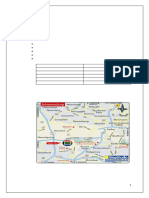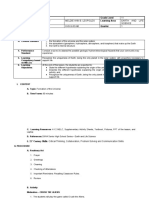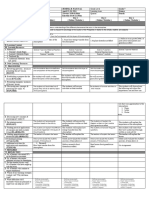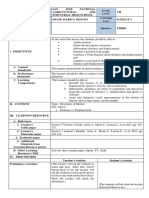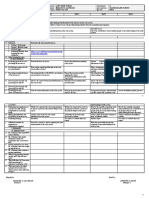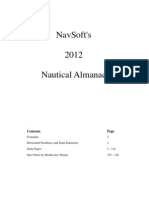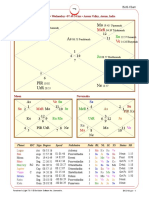Cot 1 1
Cot 1 1
Uploaded by
NOCES PRINCESS KAYE U.Copyright:
Available Formats
Cot 1 1
Cot 1 1
Uploaded by
NOCES PRINCESS KAYE U.Original Title
Copyright
Available Formats
Share this document
Did you find this document useful?
Is this content inappropriate?
Copyright:
Available Formats
Cot 1 1
Cot 1 1
Uploaded by
NOCES PRINCESS KAYE U.Copyright:
Available Formats
Republic of the Philippines
Department of Education
Region I
PANGASINAN SCHOOLS DIVISION OFFICE II
DON RAMON E. COSTALES MEMORIAL NATIONAL HIGH SCHOOL
LESSON PLAN IN SCIENCE 7
(Module No. 3) Week No. 3 Quarter 4
S.Y. 2023-2024
I. LEARNING TARGETS/ SPECIFIC OBJECTIVES INDICATORS
The learners demonstrate an understanding of the different phenomena that occur in
Content Standard:
the atmosphere.
A. Most Essential Discuss how energy from the Sun interacts with the layers of the atmosphere (S7ES -
Learning Competency IVd - 5 )
A. Define what the atmosphere is and its importance to life on Earth.
B. Learning Objectives B. Name and identify the five main layers of the atmosphere - Troposphere,
(KSA) Stratosphere, Mesosphere, Thermosphere, and Exosphere.
C. Understand the role each layer plays in protecting the Earth and supporting life.
Topic: Layers of Atmosphere
(The Effect of Light Ray in an Object)
SDG Integration:
II. CONTENT GOAL 7: Affordable and clean energy
TARGET 7.3 : Double the improvement in energy efficiency
By 2030, double the global rate of improvement in energy
efficiency.
III. LEARNING RESOURCES
A. References
1. Teacher’s Guide
2. Learner’s Materials Science 7 Learning Materials
4th Quarter Self-Learning Module 3- Lesson 1
3. Textbook
4. Additional Materials
from the LR portal
B. Other Learning
Resources
IV. PROCEDURES
A. Reviewing the Elicit: A. Preliminary Activities
previous lesson or (The activities in this 1. Greetings
presenting the new section will evoke or 2. Prayer
Gen. Luna St., Poblacion Zone II, Villasis, Pangasinan
(075) 564-4032
(075) 564-3249
www.drecmnhsvillasis.com
lesson draw out prior 3. Attendance
concepts or prior 4. Giving reminders, precautionary measures and encourage
experiences from the students to participate during discussion.
student.)
B. Lesson Proper
Pre-Activity:
The students will be grouped into 4.
They will solve a picture puzzle.
After the game, the teacher will introduce the topic and the
objectives of the lesson.
Engage: Ask the students what is in the picture.
(The activities in this
section will stimulate Ask the students what they know about the atmosphere and
their thinking and help why it is important for life on Earth.
them access and
connect prior Objectives of the lesson:
B. Establishing a knowledge as a jump A. Define what the atmosphere is and its importance to life
4
purpose for the lesson start to the present on Earth.
lesson) B. Name and identify the five main layers of the
atmosphere - Troposphere, Stratosphere, Mesosphere,
Thermosphere, and Exosphere.
C. Understand the role each layer plays in protecting the
Earth and supporting life.
C. Presenting
examples/instances of
Show a short video or images of the Earth's atmosphere
the new lesson
from space to provide a visual representation.
D. Discussing new Explore: 1. Activity Title: Exploring the Layers of the Atmosphere
concepts and practicing (In this section, 2. Objective: To understand the characteristics and
new skills #1 students will be given importance of each layer of the atmosphere.
time to think, plan, 3. Materials Needed:
investigate, and 4. Chart paper
organize collected 5. Colored markers
information; or the 6. Internet access for research
performance of the 7. Procedure:
planned/prepared 8. Divide the participants into five groups. Each group will be
activities from the assigned one layer of the atmosphere to
student's manual with research: Troposphere, Stratosphere, Mesosphere, Thermos
data gathering with phere, and Exosphere.
Gen. Luna St., Poblacion Zone II, Villasis, Pangasinan
(075) 564-4032
(075) 564-3249
www.drecmnhsvillasis.com
Each group will be responsible for creating a poster that
includes the following information about their assigned layer:
After the posters are created, each group will present their
findings to the rest of the participants.
E. Discussing new Guide Questions:
concepts and practicing
new skills #2 1. What layer of the atmosphere were you assigned and
guide questions)
what are its main characteristics?
2. How does the temperature change with altitude in your
assigned layer?
3. What unique features does your assigned layer have?
4.How does your assigned layer contribute to life on Earth or
space exploration?
5. What did you find most interesting about your assigned
layer of the atmosphere?
F. Developing mastery Explain: Discuss the Five Layers of Atmosphere
(In this section,
students will be Troposphere: This is the lowest layer of the
involved in an atmosphere, extending from the Earth's surface up to
analysis of their about 8 kilometers at the poles and about 17 kilometers
exploration. Their at the equator. This layer contains about 75% of the
understanding is atmosphere's mass and 99% of its water vapor. The
clarified and modified weather we experience on Earth occurs in the
because of reflective troposphere.
activities/ Analysis of
the gathered data and Stratosphere: Above the troposphere is the
results and being able stratosphere, which extends from about 10 kilometers
to answer the Guide to about 50 kilometers above the Earth's surface. The
Questions leading to ozone layer, which absorbs most of the Sun's harmful
the focus concept or ultraviolet radiation, is located in this layer. The
topic for the day) temperature in the stratosphere increases with altitude,
unlike the troposphere.
Mesosphere: The mesosphere extends from about 50
kilometers to about 85 kilometers above the Earth's
surface. This is the layer where most meteors burn up
upon entering the Earth's atmosphere. The temperature
decreases with altitude in this layer.
Thermosphere: The thermosphere extends from about
85 kilometers to about 600 kilometers above the Earth's
surface. This layer is characterized by high
temperatures, which can reach up to 2,500 degrees
Gen. Luna St., Poblacion Zone II, Villasis, Pangasinan
(075) 564-4032
(075) 564-3249
www.drecmnhsvillasis.com
Celsius, due to the absorption of intense solar radiation.
However, despite the high temperatures, this layer
would still feel cold to us because of the low air
pressure.
Exosphere: The exosphere is the outermost layer of the
Earth's atmosphere, extending from about 600
kilometers to about 10,000 kilometers above the Earth's
surface. This layer is mainly composed of light gases
such as hydrogen and helium. The exosphere merges
into outer space and is where satellites orbit the Earth.
Discuss the importance of each layer in protecting the Earth
and supporting life.
G. Finding practical Elaborate:
applications of the (This section will
concept allow students to Weather Forecasting: The troposphere is the layer
expand and solidify/ where all weather conditions occur. Understanding its
concretize their dynamics helps meteorologists predict weather patterns
understanding of the and forecast weather conditions.
concept and/or apply Environmental Protection: The ozone layer in the
it to a real-world stratosphere absorbs most of the Sun's harmful
situation) ultraviolet radiation. Monitoring the health of the ozone
layer is crucial for protecting life on Earth.
Space Exploration: Understanding the properties of the
mesosphere, thermosphere, and exosphere is crucial
for the successful launch and return of spacecraft. The
mesosphere is where most meteors burn up upon
entering the Earth's atmosphere, while the
thermosphere is where the International Space
Station orbits. The exosphere is the gateway to outer
space.
Telecommunications: Satellites, which facilitate global
communications and GPS systems, orbit in the
exosphere. Understanding this layer helps in the
successful deployment and operation of satellites.
Astronomy: The thermosphere is where the Northern
and Southern Lights (auroras) occur due to the
interaction of solar particles with gases in this layer.
This understanding aids astronomers and all those
interested in these phenomena.
H. Making
generalizations and Summarize the key takeaways of the lesson
abstractions about the
lesson
Gen. Luna St., Poblacion Zone II, Villasis, Pangasinan
(075) 564-4032
(075) 564-3249
www.drecmnhsvillasis.com
I. Evaluating learning Evaluation: Multiple Choice
(This section will 1. Which layer of the atmosphere is closest to Earth's
provide opportunities surface?
for concept check test a) Troposphere
items and answer b) Stratosphere
keys which are c) Mesosphere
aligned to the d) Thermosphere
learning objectives- 2. Which layer of the atmosphere contains the ozone layer?
content and a) Troposphere
performance b) Stratosphere
standards and c) Mesosphere
address d) Thermosphere
misconceptions if 3. Where do most meteors burn up upon entering Earth's
any) atmosphere?
a) Troposphere
b) Stratosphere
c) Mesosphere
d) Thermosphere
4. In which layer of the atmosphere do temperatures reach
up to 2,500 degrees Celsius?
a) Troposphere
b) Stratosphere
c) Mesosphere
d) Thermosphere
5. Which layer of the atmosphere merges into outer space
and is where satellites orbit the Earth?
a) Troposphere
b) Stratosphere
c) Mesosphere
d) Thermosphere
e) Exosphere
6.Which layer of the atmosphere contains about 75% of the
atmosphere's mass and 99% of its water vapor?
a) Troposphere
b) Stratosphere
c) Mesosphere
d) Thermosphere
7.In which layer of the atmosphere does the temperature
increase with altitude?
a) Troposphere
Gen. Luna St., Poblacion Zone II, Villasis, Pangasinan
(075) 564-4032
(075) 564-3249
www.drecmnhsvillasis.com
b) Stratosphere
c) Mesosphere
d) Thermosphere
8. Which layer of the atmosphere is characterized by low air
pressure despite high temperatures?
a) Troposphere
b) Stratosphere
c) Mesosphere
d) Thermosphere
9. Which layer of the atmosphere is the outermost layer?
a) Troposphere
b) Stratosphere
c) Mesosphere
d) Thermosphere
e) Exosphere
10. In which layer of the atmosphere does the weather we
experience on Earth occur?
a) Troposphere
b) Stratosphere
c) Mesosphere
d) Thermosphere
J. Additional activities Extend: Encourage students to explore current issues related to the
for application and (This section gives a atmosphere, such as air pollution or climate change, and
remediation situation that explains discuss how these impact the Earth's layers.
the topic in a new
context, or integrates
it into another
disciple/ societal
concern)
The ratee’s class has no identified learner/s with disabilities, giftedness and/or talents.
The ratee’s class has no identified learner/s from indigenous groups.
Prepared:
LADY ABIGAIL R. MINA
Special Science Teacher I
Checked:
JERRY R. TAMAYO RICY O. CARANZO
Master Teacher II OIC- Science Department
Gen. Luna St., Poblacion Zone II, Villasis, Pangasinan
(075) 564-4032
(075) 564-3249
www.drecmnhsvillasis.com
You might also like
- DLL Earth and Life Science Week 1Document3 pagesDLL Earth and Life Science Week 1KrisJoyce Reyes-Politico100% (10)
- 2023 T1 GEO8 WorksheetsDocument20 pages2023 T1 GEO8 Worksheetsnalz.letsoaloNo ratings yet
- Semi-Detailed Lesson Plan in Science 7 - Layers of The AtmosphereDocument6 pagesSemi-Detailed Lesson Plan in Science 7 - Layers of The AtmosphereKARL JOSE IBARRIENTOS100% (10)
- COT-Atmosphere Lesson Plan, Grade 7. 4th QuarterDocument5 pagesCOT-Atmosphere Lesson Plan, Grade 7. 4th QuarterLIZETTE GARCIA100% (5)
- Lesson Plan (Understanding Typhoon)Document6 pagesLesson Plan (Understanding Typhoon)jelena jorgeo100% (1)
- Layers of The EarthDocument3 pagesLayers of The EarthHAROLD PAYUNANNo ratings yet
- Daily Lesson Plan School Grade Level Teacher Learning Area Teaching Date and Time QuarterDocument2 pagesDaily Lesson Plan School Grade Level Teacher Learning Area Teaching Date and Time QuarterJennifer Magango100% (2)
- Earth and Life Science DLLDocument6 pagesEarth and Life Science DLLGsoon Sibulan100% (4)
- Transient Lunar PhenomenaDocument45 pagesTransient Lunar PhenomenanevilleNo ratings yet
- Sripati PaddhatiDocument196 pagesSripati PaddhatiRodolfo Tinoco Veronese100% (7)
- COT 2022 2023 Layers of AtmosphereDocument5 pagesCOT 2022 2023 Layers of AtmosphereApril Glory Sicuando ArguellesNo ratings yet
- Norada, Jessica Revised LPDocument6 pagesNorada, Jessica Revised LPJessica Hijada NoradaNo ratings yet
- LC 4Document4 pagesLC 4JT SaguinNo ratings yet
- Earth and Life Sci W1-5 Lesson 5Document4 pagesEarth and Life Sci W1-5 Lesson 5mariafelez.matignao01No ratings yet
- The Four Subsystems of The Earth: I. Objectives (What Will Your Students Be Able To Do by The End of The Class)Document3 pagesThe Four Subsystems of The Earth: I. Objectives (What Will Your Students Be Able To Do by The End of The Class)Mitchelle Dawn Paye100% (1)
- Lesson Plan in Science 7: Objectives A. Most Essential Learning Competency: (MELC) B. Code: C. Learning ObjectivesDocument6 pagesLesson Plan in Science 7: Objectives A. Most Essential Learning Competency: (MELC) B. Code: C. Learning ObjectivesLiezl BallesterosNo ratings yet
- LP7 Layers of AtmosphereDocument11 pagesLP7 Layers of AtmosphereparkterradoNo ratings yet
- 1 - Layers of The EarthDocument4 pages1 - Layers of The EarthJinkie LandichoNo ratings yet
- DLL Seismic WavesDocument3 pagesDLL Seismic WavesJade Cyrus S. Llemos100% (1)
- Earth and Life Science Week1Document6 pagesEarth and Life Science Week1Meldie Ann B. LeopoldoNo ratings yet
- Earth and Life LP CompilationDocument34 pagesEarth and Life LP CompilationAgustines, Marie Char C.No ratings yet
- Biodiversity Week 1Document5 pagesBiodiversity Week 1Trisha Melrose MilanesNo ratings yet
- Earth & Life Science Day 1Document8 pagesEarth & Life Science Day 1Maria Theresa Deluna Macairan100% (1)
- Layers of The Atmosphere Lesson Plan 7e'sDocument7 pagesLayers of The Atmosphere Lesson Plan 7e'slenie bacalsoNo ratings yet
- Cot 3Document6 pagesCot 3EM GinaNo ratings yet
- 2formationofheavyelementsDocument4 pages2formationofheavyelementsAngel AlibangbangNo ratings yet
- Plate TectonicsDocument2 pagesPlate TectonicsShang KirsteinNo ratings yet
- Earth and Life Sci DLLDocument3 pagesEarth and Life Sci DLLPolPelonioNo ratings yet
- Q1 EARTH AND SCIENCE WEEK 4Document3 pagesQ1 EARTH AND SCIENCE WEEK 4Dennis Jasmin TorneNo ratings yet
- DLL 03Document3 pagesDLL 03RamcieNo ratings yet
- 1st Quarter 2017-2018Document77 pages1st Quarter 2017-2018MichelleAdanteMorong100% (1)
- Semi DetailedDocument6 pagesSemi DetailedMeldie Ann B. LeopoldoNo ratings yet
- LP-IN-AOL AlcantaraDocument6 pagesLP-IN-AOL Alcantarajbdalumpines13No ratings yet
- 1ST QUARTER WEEK 1 PHYSICAL SCIENCE LESSON EXEMPLARDocument6 pages1ST QUARTER WEEK 1 PHYSICAL SCIENCE LESSON EXEMPLARanthonydongonNo ratings yet
- DLLQ3W7Document11 pagesDLLQ3W7JEMIMA BERNARDONo ratings yet
- Greenhouse EffectDocument7 pagesGreenhouse EffectwannieNo ratings yet
- DETAILED LP Distance Vs DisplacementDocument8 pagesDETAILED LP Distance Vs DisplacementDiane Marr Nicolas DencioNo ratings yet
- CO LP 2023 1st SciDocument10 pagesCO LP 2023 1st SciPerlita CarpenteroNo ratings yet
- Phuol LP - Microscope - 012603Document2 pagesPhuol LP - Microscope - 012603servantmarklNo ratings yet
- Earth and Life Sci W 1-5 Lesson 1Document2 pagesEarth and Life Sci W 1-5 Lesson 1mariafelez.matignao01No ratings yet
- Grade 10-DLL Earth Sci W1Document5 pagesGrade 10-DLL Earth Sci W1MARIE JOIE TORRESNo ratings yet
- Q2 W6Document3 pagesQ2 W6Mae Uayan Prisco-TagaraoNo ratings yet
- CLE Grade 7 - 1Q 3rd Weekly Lesson Plan - 2023Document3 pagesCLE Grade 7 - 1Q 3rd Weekly Lesson Plan - 2023luiNo ratings yet
- 4g11 Earth's SubsystemDocument2 pages4g11 Earth's SubsystemAngel AlibangbangNo ratings yet
- June 24-28Document2 pagesJune 24-28Maricris LacwasanNo ratings yet
- Week 5Document7 pagesWeek 5Michelle Ramirez Co-GonzalesNo ratings yet
- Week 5Document7 pagesWeek 5Michelle Ramirez Co-GonzalesNo ratings yet
- CLE Grade 7 - 2Q 6th Weekly Lesson Plan - 2023Document3 pagesCLE Grade 7 - 2Q 6th Weekly Lesson Plan - 2023luiNo ratings yet
- CLE Grade 7 - 3Q 10th Weekly Lesson Plan - 2023Document3 pagesCLE Grade 7 - 3Q 10th Weekly Lesson Plan - 2023luiNo ratings yet
- SDLP - FossilDocument3 pagesSDLP - FossilIan MarcellanoNo ratings yet
- DLP EarthsciDocument3 pagesDLP Earthscijefferson cristobalNo ratings yet
- Grade 5 DLL Science 5 q4 Week 2Document3 pagesGrade 5 DLL Science 5 q4 Week 2Danica AlejandroNo ratings yet
- A Lesson Plan On TyphoonDocument5 pagesA Lesson Plan On TyphoonAnalou Jade MonleonNo ratings yet
- 14.5 Correlation Rock LayersDocument4 pages14.5 Correlation Rock LayersAngel AlibangbangNo ratings yet
- Detailed Lesson Plan: Sta. Margarita National High School Grade 10 Jupiter Pea C. Panlilio Science FirstDocument12 pagesDetailed Lesson Plan: Sta. Margarita National High School Grade 10 Jupiter Pea C. Panlilio Science FirstPEA PANLILIONo ratings yet
- Geothermal Energy Day 2 LPDocument4 pagesGeothermal Energy Day 2 LPLadelyn BugarinNo ratings yet
- DLP CO1Document12 pagesDLP CO1NanetteNo ratings yet
- Earth and Life ScienceDocument4 pagesEarth and Life ScienceMaffie Estremos-braulio MatignaoNo ratings yet
- GRADES 1 To 12 Daily Lesson Log: I. ObjectivesDocument5 pagesGRADES 1 To 12 Daily Lesson Log: I. ObjectivesAnonymous 7BpT9OWPNo ratings yet
- CLE Grade 7 - 1Q 4th Weekly Lesson Plan - 2023Document3 pagesCLE Grade 7 - 1Q 4th Weekly Lesson Plan - 2023luiNo ratings yet
- CLE Grade 7 - 2Q 5th Weekly Lesson Plan - 2023Document3 pagesCLE Grade 7 - 2Q 5th Weekly Lesson Plan - 2023luiNo ratings yet
- 2024-LS-G7-CUF-Q4-WEEK5-SCIENCE-PEACE & VALUES EDUCATIONDocument16 pages2024-LS-G7-CUF-Q4-WEEK5-SCIENCE-PEACE & VALUES EDUCATIONTino PandomaNo ratings yet
- Astrology & Love AffairsDocument2 pagesAstrology & Love AffairssunlifecNo ratings yet
- Science and Technology Study Material For UPSC IAS Civil Services and State PCS Examinations - WWW - Dhyeyaias.comDocument28 pagesScience and Technology Study Material For UPSC IAS Civil Services and State PCS Examinations - WWW - Dhyeyaias.comdebjyoti sealNo ratings yet
- CAAO TutorialDocument83 pagesCAAO TutorialAyushmaan DeyNo ratings yet
- Stellar EvolutionDocument3 pagesStellar Evolutionips.uoc.2021No ratings yet
- Yogi Planet: Yogi Avayogi Yogi AvayogiDocument3 pagesYogi Planet: Yogi Avayogi Yogi AvayogiDrNerella RajaSekhar100% (2)
- Kalaw: JasonDocument3 pagesKalaw: JasonJohn Mark FloresNo ratings yet
- Dark Matter and Dark EnergyDocument17 pagesDark Matter and Dark EnergyNivethaNo ratings yet
- 2012 Nautical AlmanacDocument136 pages2012 Nautical AlmanacRenato FonsecaNo ratings yet
- The MoonDocument8 pagesThe MoonSherub TenzinNo ratings yet
- Commodities Trading by KT AstrologerDocument1 pageCommodities Trading by KT AstrologerArunodaya Kumar VermaNo ratings yet
- Nakshatra Lords, Nakshatra Lord, Nakshatras and Their Lords, Nakshatra Lord Table, 27 Nakshatras and Their Lords, Nakshatras & LDocument1 pageNakshatra Lords, Nakshatra Lord, Nakshatras and Their Lords, Nakshatra Lord Table, 27 Nakshatras and Their Lords, Nakshatras & Lreckarthikbabu7357No ratings yet
- Himso Ipa Level 3Document2 pagesHimso Ipa Level 3Yuliati Yuliati100% (1)
- Astronomy For Beginners - 3rd EditionDocument164 pagesAstronomy For Beginners - 3rd EditionFerenc Kaliba0% (1)
- Astronomer Avi Loeb Says Aliens Have VisitedDocument1 pageAstronomer Avi Loeb Says Aliens Have VisitedDonald TrummpNo ratings yet
- Arnav GoswamiDocument8 pagesArnav Goswamirkstudyc_gmailNo ratings yet
- Adimurthy Brief Biodata Feb 2023Document1 pageAdimurthy Brief Biodata Feb 2023Mrs. K.V. VaralakshmiNo ratings yet
- Orbit and RotationDocument3 pagesOrbit and RotationEzzie DoroNo ratings yet
- Training Infographics PPT FormatDocument33 pagesTraining Infographics PPT Formatbaton58559No ratings yet
- Iao 2011Document22 pagesIao 2011Omidreza NazariNo ratings yet
- DiS Poster TenebrisSystem BlackAndWhiteDocument1 pageDiS Poster TenebrisSystem BlackAndWhiteel-sOdANo ratings yet
- Natal Chart Angle DetailDocument1 pageNatal Chart Angle DetailLia UlhaqNo ratings yet
- Facts About The Planet NeptuneDocument6 pagesFacts About The Planet Neptunefactsplanetmercury100% (2)
- Tell Me Your Photo Story!Document57 pagesTell Me Your Photo Story!DivineN.PorolNo ratings yet
- New Scientist Essential Guide No24 2024Document100 pagesNew Scientist Essential Guide No24 2024Roger Kyaw Swar Phone MaungNo ratings yet
- Altitude of The Sun and Module Tilt ExamplesDocument2 pagesAltitude of The Sun and Module Tilt ExamplesMelecio Jesus Leano Jr.No ratings yet
- Space PhysicsDocument10 pagesSpace PhysicsDark VariantNo ratings yet
- Pretty Aesthetic Notes For School - by SlidesgoDocument13 pagesPretty Aesthetic Notes For School - by SlidesgoMariana MontalvoNo ratings yet

